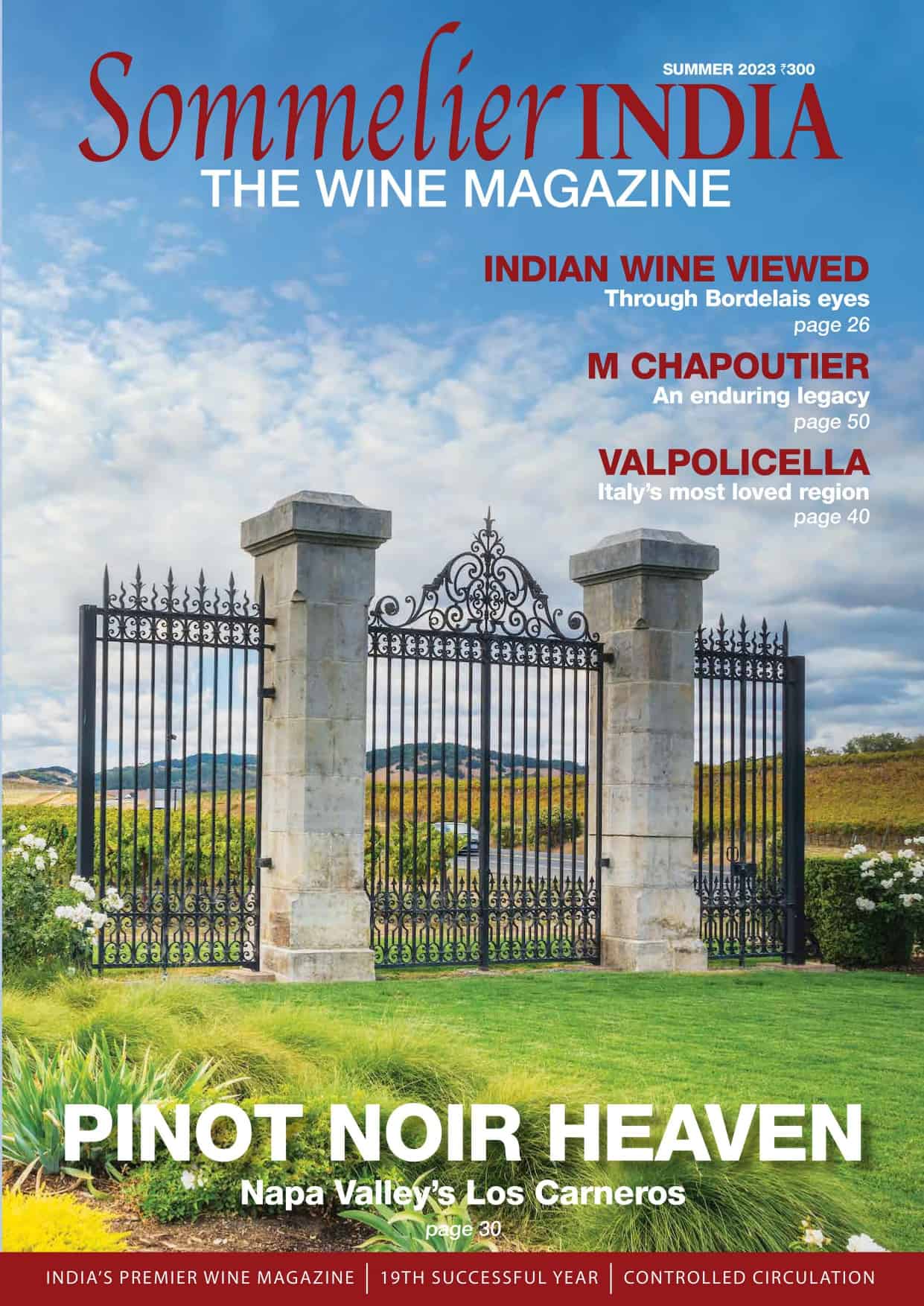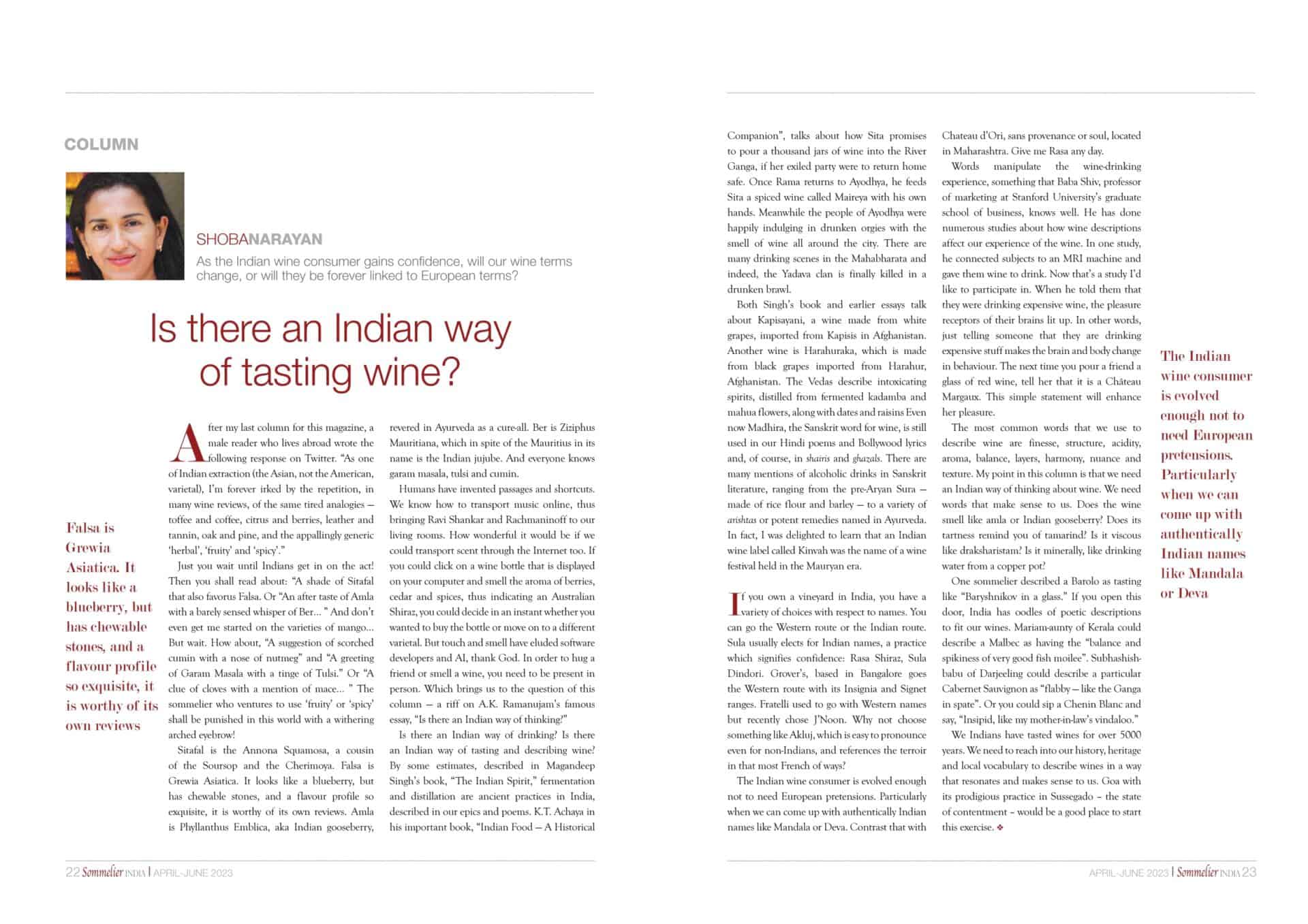As the Indian economy gains confidence, will our wine terms change, or will they be forever linked to European terms? After my last column for this magazine, a male reader who lives abroad wrote the following response on Twitter. “As one of Indian extraction (the Asian, not the American, varietal), I’m forever irked by the repetition, in many wine reviews, of the same tired analogs – toffee and coffee, citrus and berries, leather and tannin, oak and pine, and the appallingly generic “herbal”, “fruity” and “spicy”. Just you wait until Indians get in on the act, I writhe. Then you shall read about: “A shade of Sitafal that also favors Falsa. Or. An after taste of Amla with a barely sensed whisper of Ber… ” And don’t even get me started on the varieties of mango… But wait. How about: “A suggestion of scorched cumin with a nose of nutmeg.” A greeting of Garam Masala with a tinge of Tulsi.” Or. “A clue of cloves with a mention of mace… ” The sommelier who dares use “fruity” or “spicy” shall be punished in this world with a withering arched eyebrow!
Sitafal is the Annona Squamosa, a cousin of the Soursop and the Cherimoya. Falsa is Grewia Asiatica– looks like a blueberry, but has chewable stones, and a flavor profile so exquisite, it is worthy of its own reviews. Amla is Phyllanthus Emblica, aka Indian gooseberry, revered in Ayurveda as a cure-all. Ber is Zizyphus Mauritiana, which in spite fo the Mauritius in its name is the Indian jujube. And you know garam masala, tulsi and cumin.
Humans have invented passages and shortcuts. We know how to transport music online thus bringing Ravi Shankar and Rachmaninoff to our living rooms. How wonderful it would be if we could transport scent through the Internet. If you could click on a wine bottle that is displayed on your computer and smell the aroma of berries, cedar and spices– thus indicating an Australian shiraz, you could decide in an instant whether you want to buy the bottle or move on to a different varietal. But touch and smell have eluded software developers and AI, thank God. In order to hug a friend, or smell a wine, you need to be present in person.
Which brings us to the question of this column– which itself is a riff on A.K. Ramanujam’s famous essay, “Is there an Indian way of thinking?”
Is there an Indian way of drinking? Is there an Indian way of tasting and describing wine?
By some estimates, described in Magandeep Singh’s book, “The Indian Spirit,” fermentation and distillation are ancient practices in India, described in our epics and poems.
K.T. Achaya in his important book, “Indian Food– a historical companion,” talks about how Sita promises to pour a thousand jars of wine into the river, Ganga, if her exiled party were to return home safe. Once Rama returns to Ayodhya, he feeds Sita a spiced wine called Maireya with his own hands. Meanwhile the people of Ayodhya were happily indulging in drunken orgies with the smell of wine all around the city.
There are many drinking scenes in the Mahabharata and indeed, the Yadava clan is finally killed in a drunken brawl.
Both Singh’s book and earlier essays talk about Kapisayani, a wine made from white grapes, imported from Kapisis in Afghanistan. The other is Harahuraka, which is wine made from black grapes imported from Harahur, Afghanistan. The Vedas describe intoxicating spirits drinks, distilled from fermented kadamba and mahua flowers, along with dates and raisins Even now Madhira, the Sanskrit word for wine, is still used in our Hindi poems and Bollywood lyrics and, of course, shairis and ghazals. There are many names of alcoholic drinks in Sanskrit literature, ranging from the pre-Aryan Sura– made of rice flour and barley to a variety of arishtas or potent remedies named in Ayurveda. In fact, I was delighted to find out that an Indian wine label called Kinvah was the name of a wine festival held in the Mauryan era.

If you own a vineyard in India, you have choices with respect to names. You can go the Western route or the Indian route. Sula usually elects for Indian names, which signifies confidence: Rasa Shiraz, Sula Dindori. Grover’s, based in Bangalore goes the Western route with its Insignia and Signet ranges. Fratelli used to do all Western names but recently chose J’noon. Why not choose something like Akluj, which is easy to pronounce even for non-Indians, and reference the terroir in that most French of ways? The Indian wine consumer is evolved enough not to need such European pretensions. Particularly when we can come up with authentically Indian names like Mandala or Deva. Contrast that with Chateau d’Ori, sans provenance or soul– located in Maharashtra. Give me Rasa anyday.
Words manipulate the wine-drinking experience, something that Baba Shiv, professor of marketing at Stanford University’s graduate school of business knows well. Shiv has done numerous studies about how wine descriptions affect our experience of the wine. In one study, he connected subjects to an MRI machine and gave them wine to drink. Now that’s a study I’d like to participate in. When he told them that they were drinking expensive wine, the pleasure receptors of their brains lit up. In other words, just telling someone that they are drinking expensive stuff makes the brain and body change in behavior. The next time you pour a friend a glass of red wine, tell her that it is a Château Margaux. This simple statement will enhance her pleasure.
The most common words that we use to describe wine are finesse, structure, acidity, aroma, balance, layers, harmony, nuance and texture. My point in this column is that we need an Indian way of thinking about wine. We need words that make sense to us. Does the wine smell like amla or Indian gooseberry? Does its tartness remind you of tamarind? Is it viscous like draksharistam? Is it minerally– like drinking water from a copper pot?
One sommelier described a Barolo as tasting like “Baryshnikov in a glass.” If you open this door, India has oodles of poetic descriptions to fit our wines. Mariam-aunty of Kerala could describe a Malbec as having the “balance and spikiness of very good fish moily.” Subhashish-babu of Darjeeling could describe a particular Cabernet Sauvignon to be “flabby–like the Ganga in spate.” Or you could sip a Chenin blanc and say, “insipid, like my mother-in-law’s vindaloo.”
We Indians have tasted wines for over 5000 years. We need to reach into our history, heritage, and local vocabulary to describe wines in a way that resonates and makes sense to us. Goa with its prodigious practice in Susegado– the art of living would be a good place to start this exercise.





Well written article Shobha.I have struggled with finding correct words with which a consumer in India would find a connect to be able to understand wines better. This topic definitely needs a research.
Interesting learning!